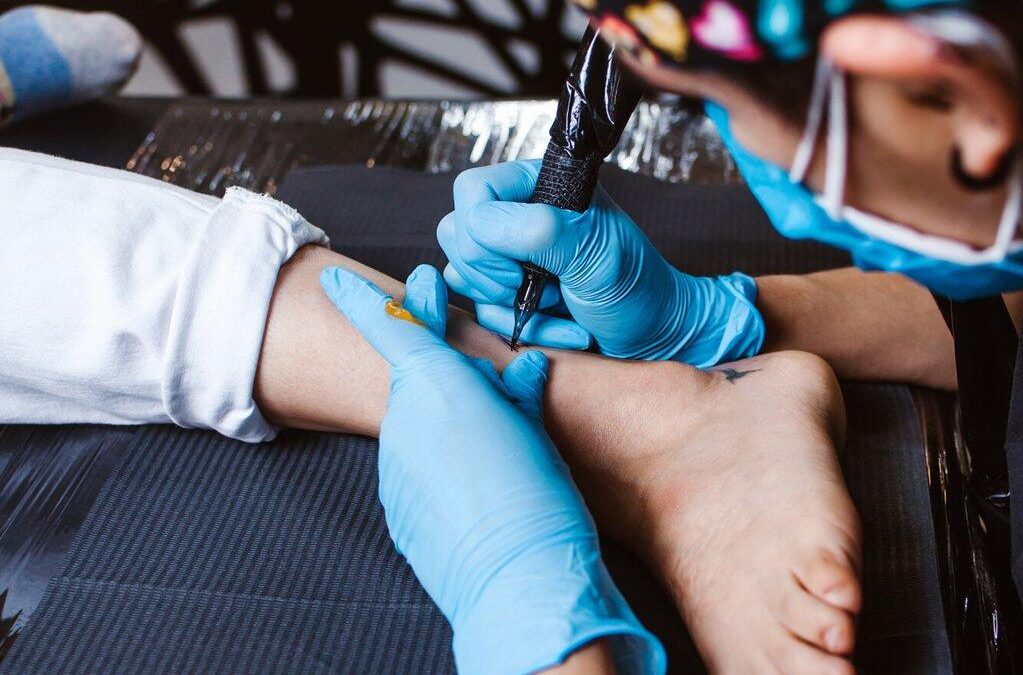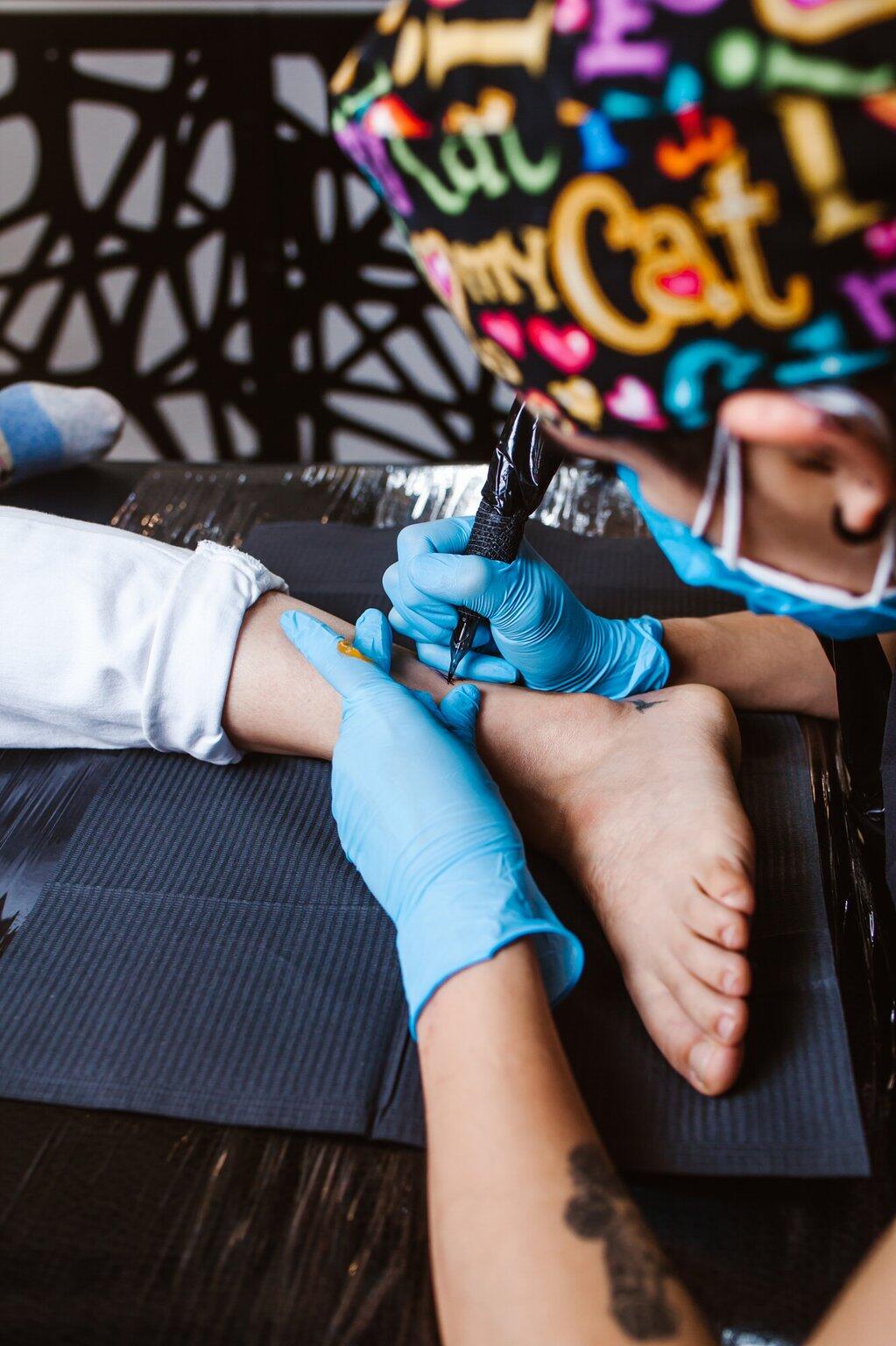
Do Fine Line Tattoos Age Well
Do Fine Line Tattoos Age Well? Expert Insights
You’re scrolling through Instagram, mesmerized by delicate, whisper-thin tattoos adorning seemingly flawless skin. The urge to book an appointment for your own fine line masterpiece is overwhelming.
But before you dive in, a nagging question surfaces: Will that intricate design still look crisp and elegant in 5, 10, or 20 years? As the popularity of fine line tattoos soars, so do concerns about their longevity.
Read on to find out, do fine line tattoos age well?
Skin Type and the Tattoo Aging Process
 Skin type can affect the tattoo aging process. People with oily skin may experience faster fading because the skin’s natural oils can cause more ink to be lost.
Skin type can affect the tattoo aging process. People with oily skin may experience faster fading because the skin’s natural oils can cause more ink to be lost.
Dry skin is more prone to cracking and flaking, which can impact the sharpness of the tattoo. Properly moisturizing the skin both during the healing process and long-term can help prevent these issues, keeping the fine lines crisp and defined.
The elasticity of your skin also affects how well your tattoo will hold up over time. For individuals with more elastic skin, tattoos tend to age better as the skin stretches less and retains its original texture.
Aging skin, which naturally loses elasticity and collagen over time, may cause the fine lines to spread, blur, or distort, particularly in areas where the skin is thinner. In contrast, areas with thicker skin often retain the design’s sharpness for a longer period.
Consistently caring for your skin can help mitigate this and extend fine line tattoo longevity.
Tattoo Placement
Where you choose to place your fine line tattoo has a significant impact on how well it will age. High-movement areas like:
- Hands
- Fingers
- Elbows
- Feet
are more prone to fading and blurring over time. These areas experience constant stretching, bending, and friction, which can cause the delicate lines of a fine line tattoo to spread or lose definition more quickly.
Tattoos placed on high-friction zones like the sides of the body, underarms, or inner thighs may experience faster wear as they are more exposed to rubbing against clothing and the natural movement of the skin.
Ink Quality and Technique
High-quality ink generally holds up better over time, offering more resistance to fading and blurring. Professional tattoo artists often use inks that are specifically designed to maintain their vibrancy and longevity, even as the skin ages and goes through changes.
Cheaper or lower-quality inks, on the other hand, may fade faster, especially in fine line tattoos where the ink is applied in minimal amounts.
The tattooing technique itself is equally important. Fine line tattoos require precision, as they involve placing thin lines with a single needle, often at a more superficial level than traditional tattoos. If the artist does not place the ink deep enough, the tattoo may fade prematurely.
Blow Outs
If the ink is placed too deeply, it can cause a blowout, where the ink spreads beneath the skin and causes the lines to blur.
Skilled tattoo artists are well-versed in the delicate balance required for fine line work, ensuring the ink is applied at the right depth to minimize the risk of blurring while ensuring longevity.
Color Choice
Black ink is the most commonly used for fine line tattoos due to its durability and resilience over time. Black tends to hold up better than lighter colors, maintaining its contrast and sharpness even as the tattoo fades slightly with age. This makes it an ideal choice for minimalist designs where clarity and crisp lines are essential.
Colored inks, especially lighter shades like pastels or white, are more prone to fading. Fine line tattoos that incorporate light colors may lose their vibrancy faster, particularly when exposed to sunlight.
Over time, these colors may become less distinct, blending into the skin and causing the tattoo to lose its definition. While colored fine line tattoos can be stunning, they often require more frequent touch-ups to keep the design looking fresh and vibrant.
Color combinations can impact how the tattoo ages. Darker colors tend to provide better contrast and last longer, while lighter hues may require extra maintenance.
Minimalist Design
With fewer details and thin, delicate lines, minimalist tattoos rely heavily on precision and clarity to maintain their appeal. As the tattoo ages and the skin naturally changes, even slight fading or blurring can significantly impact the look of a minimalist design.
The absence of bold lines or shading means any imperfections in the ink or linework may become more noticeable over time.
Tattoo Trends and Long-Term Aesthetics
It’s important to consider how tattoo trends evolve over time. While they may be trendy now, what’s considered stylish today may not have the same appeal in the future.
Fine line tattoos often carry a timeless elegance that appeals to those seeking subtle body art. These tattoos may not stand out as boldly as traditional designs, but they offer a refined and understated look that can age gracefully if done well.
However, because fine line tattoos are minimalist in nature, even slight changes in the ink or blurring of lines can significantly affect their aesthetic.
It’s essential to think about how the tattoo will look not just in a few years but over the course of decades. Choosing a timeless design rather than something that’s currently trendy can help ensure the tattoo remains aesthetically pleasing, even as tattoo styles and personal preferences change.
Sun Exposure
Ultraviolet rays can cause the tattoo ink to break down over time. Fine line tattoos, with their delicate and thin lines, are particularly susceptible to these effects.
The subtle nature of these designs means even slight fading can drastically change their appearance, causing them to lose their crisp, sharp look.
To help your fine line tattoo age well, protecting it from the sun is essential. Applying a high-SPF sunscreen regularly, especially in areas that are frequently exposed like the forearms, shoulders, and hands, can significantly slow the fading process.
Wearing protective clothing, such as long sleeves or hats, when spending extended periods outdoors also helps shield the tattoo from UV damage.
Skin Tone and Tattoo Aging
Darker skin tones naturally reflect and absorb light differently than lighter skin tones, which can affect the visibility and contrast of a fine line tattoo over time.
On darker skin, fine lines may not appear as crisp initially due to the contrast between ink and skin, and fading may become more noticeable as the tattoo ages. However, darker skin tones are often less prone to (but importantly, not immune from) sun damage, which can help slow down the fading process.
For those with lighter skin tones, fine line tattoos may appear sharper and more defined in the early stages, but lighter skin is generally more susceptible to UV damage, which can cause faster fading and blurring.
Get Professional Advice For Long-Lasting Tattoos
A skilled artist can provide guidance on every aspect of the process, from selecting the right placement to choosing ink that will hold up over time.
- They might suggest:
- Adjusting the line thickness
- Choosing a design that complements natural skin movement
- Selecting a placement that minimizes friction and sun exposure
Aftercare Practice
Proper aftercare is essential to ensuring a fine line tattoo ages well. The initial healing process is a critical time for your tattoo, and how you care for it in the first few weeks can significantly impact its longevity.
Keeping the tattoo clean and moisturized is the foundation of good aftercare. It’s important to wash the tattoo gently with mild, fragrance-free soap to prevent infection and allow the skin to heal without irritation.
Using a fragrance-free, non-petroleum-based moisturizer helps prevent the skin from drying out, which can lead to flaking and fading.
During the healing phase, avoid scratching or picking at scabs, which can disrupt the ink and cause lines to blur or fade unevenly.
It’s important to avoid submerging the tattoo in water, such as in:
- Pools
- Hot tubs
- Oceans
- Lakes
until it has completely healed, as prolonged moisture can affect the healing process.
Tattoo Maintenance Tips: Touch Ups
It’s generally recommended to get a touch-up every few years, depending on how your tattoo has aged and its placement on the body. Areas that experience more friction, movement, or sun exposure may require touch-ups sooner.
During a touch-up session, the artist will carefully trace over the existing lines, refining any areas that have blurred or faded. This process helps to revitalize the tattoo’s detail, ensuring it remains crisp and well-defined.
When scheduling a touch-up, it’s often best to return to the original tattoo artist, as they are familiar with the design and their technique will closely match the original work.
If this isn’t possible, choosing an artist who specializes in fine line work is key to maintaining the integrity of the tattoo. It’s also important to keep in mind that touch-ups may become more challenging as the tattoo and skin age, so consistent maintenance early on can help preserve the design’s quality in the long term.
Alternative Options for Longer-Lasting Tattoos
There are several alternatives to traditional fine line tattoos that may offer greater longevity while maintaining an elegant aesthetic.
One option is to incorporate bolder lines or shading into the design. While fine line tattoos are known for their delicate appearance, adding slightly thicker lines or subtle shading can create a design that ages more gracefully.
These elements provide more structure, helping the tattoo remain crisp and clear as it fades over time.
You could also choose a design with more negative space or simpler patterns. Minimalist tattoos that rely on fewer intricate details can hold up better as the skin changes and the ink settles. Designs with more open areas allow for natural fading without significantly impacting the overall look of the tattoo.
Designs integrating geometric shapes, dots, or small symbols can be more resilient to the effects of aging than detailed illustrations.
Choosing a Tattoo Shop
Selecting the right tattoo shop is a critical step in ensuring you have long-lasting tattoos. Not all tattoo shops specialize in fine line work, so it’s essential to do thorough research to find an artist and studio with proven experience in this delicate style. Reputation and reviews are a great place to start.
Look for shops that have a track record of producing high-quality fine line tattoos that remain crisp and defined over time. Visiting the shop’s social media pages or portfolio can give you a sense of their expertise and consistency in this particular technique.
Make sure the tattoo shop prioritizes hygiene and safety standards. A clean, sterile environment is vital to avoid infections, which can negatively impact both the healing process and the long-term appearance of the tattoo.
Make sure the shop follows strict sanitation protocols, such as using new needles and sterile equipment for every client. A professional tattoo shop should be licensed and comply with all local health regulations.
Check The Vibe
Consider the overall vibe of the shop. A reputable tattoo shop should make you feel comfortable and confident in the process. The artist should be open to discussing placement, ink quality, and aftercare instructions to ensure your tattoo looks great both now and years down the road.
Fine Line Tattoo Problems
If you notice there’s an issue, it’s important to address it right away.
The first step is to contact your tattoo artist as soon as you notice something unusual. Reputable artists are usually open to providing advice or even offering a touch-up to correct issues like fading or uneven healing.
In cases where the tattoo has significantly changed or spread beyond what a touch-up can fix, you might consider laser tattoo removal to reduce or lighten the problematic areas. While complete removal may not be necessary, partial removal or fading can allow you to rework or enhance the design with more defined lines.
Do Fine Line Tattoos Age Well?
Do fine line tattoos age well? It depends. With a solid artist and a commitment to maintenance, you won’t have to worry about your fine line art.
Are you ready for your next tattoo? Skin Factory Tattoo has amazing artists available at each of our locations who are ready to get started.
Contact us today.
Find a Skin Factory location near you.

